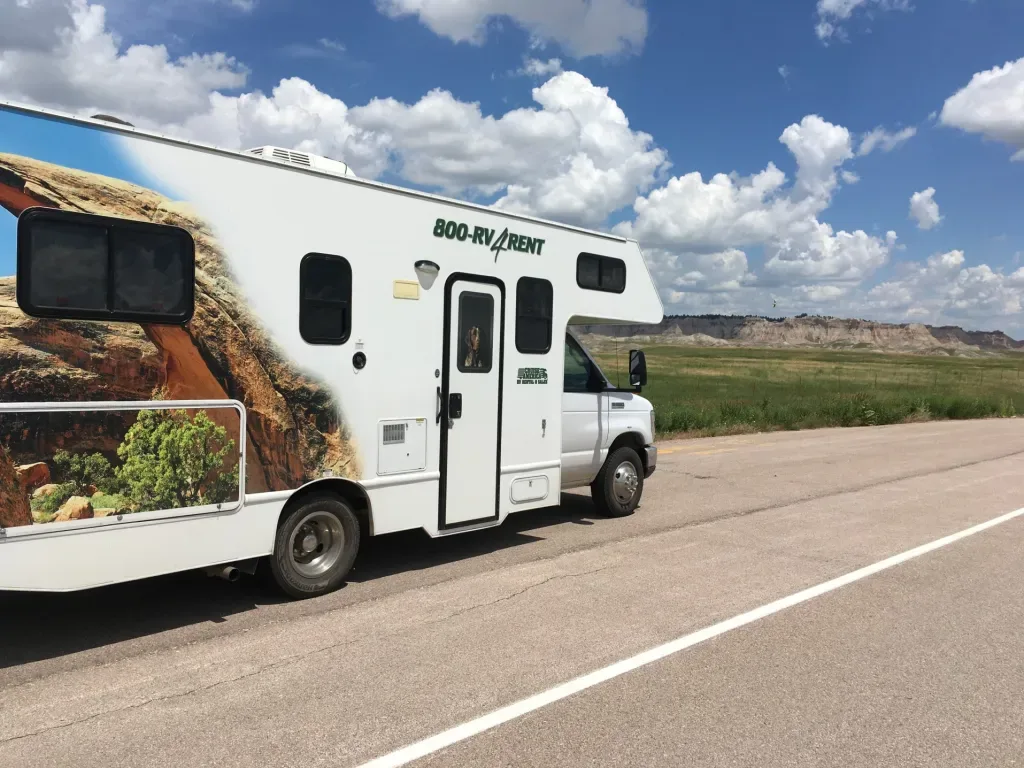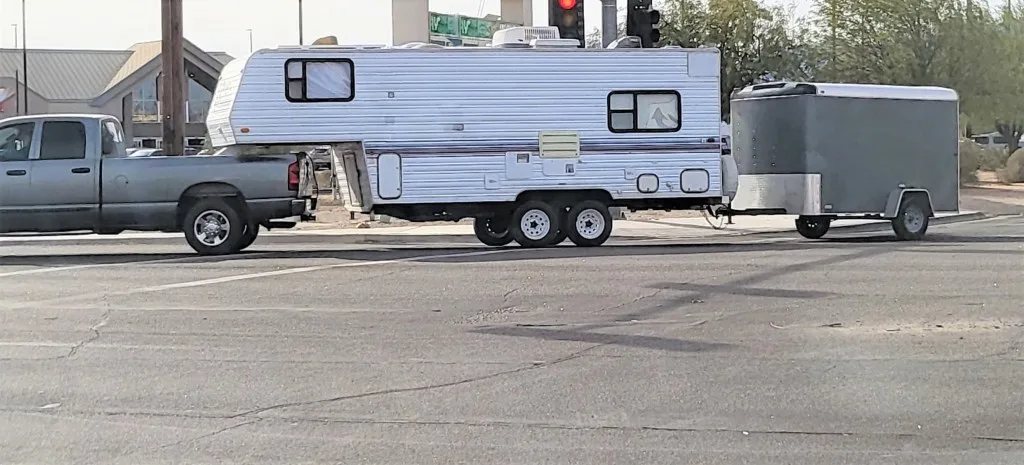You never want to be “that person” on the road. You know who we’re talking about — the driver who’s so noticeably obnoxious, aggressive, or otherwise bad that every other vehicle around them is doing their best to avoid them.
Unfortunately, this can happen all too easily for new RVers and some experienced ones, too.
So what habits should you make sure you avoid to remain a good neighbor on the road?
Here’s a closer look.

Is Driving an RV Difficult?
The answer largely depends on what you’re used to driving. Compared to driving a small or midsize car, driving an RV can be a little more difficult. You have to deal with a significantly larger vehicle’s space issues and handling.
But those who drive SUVs or pickup trucks will have fewer issues adjusting.
Those who’ve driven larger vehicles like buses or semi-trucks will have little trouble. However, even first-time drivers can learn to handle just about any RV with a bit of practice.
Pro Tip: These are the best trucks for towing.
What Are the Easiest RVs to Drive?
For most RVers (and drivers in general), smaller rigs are easier to handle than larger ones. This means you’ll probably have an easier time driving with a Class B, small Class C, or small travel trailer.
On the flip side, you may have more difficulty maneuvering Class A motorhomes or fifth wheels simply due to their larger size and less nimble handling.
Deeper Dive: Here’s a full breakdown of the easiest RVs to drive.

How Fast Can You Safely Drive an RV?
This answer will depend on several factors, including the local laws and your comfort level. In many places, RVs are allowed to drive the normal speed limit. There are certain exceptions to this based on the rules of individual states or roads.
These usually require vehicles towing trailers to travel below the standard speed limit.
If you’re towing a car behind your motorhome, you may also have limitations on the speed you can travel. With all this in mind, most people end up traveling 50-70 MPH on the highway and half that speed or less on local roads that may be more difficult to navigate.
Keep in mind: When is it too windy to drive an RV?
5 RV Driving Habits That Make People Instantly Dislike You
So what are the most surefire ways to make all sorts of enemies on the road during your next RV trip? Here are five habits that will annoy just about everyone else on the road.
1. Driving an RV Like a Car
It should be evident to everyone, but some people still don’t get it. Even the smallest RVs will handle significantly differently than most cars and require a different driving style.
You may be able to get away with behaviors like frequent lane changes or last-minute turns in your car.
However, trying these things in a much larger vehicle can make you the least popular person on the road.
2. Speeding
Speeding isn’t just annoying; it’s also very dangerous, especially when you weigh as much as an RV or trailer.
Simple physics can tell you heavier objects need longer to stop, and speeding can mean an accident that could have been avoided at a slower pace.
That’s not to mention the anxiety-inducing experience of having a giant, fast-moving RV roar up behind or beside you on the road!
Pro Tip: This is the ideal RV driving & towing speed.

3. Filling Up at Normal Gas Stations
Most regular gas stations simply can’t accommodate RVs. Their awnings may be too low, or there could be too little space between the pumps. RVers who fill up at these spots almost invariably cause problems. Sometimes this is from trying to maneuver around the station. They might prevent others from filling up and block pumps.
Many gas stations aren’t that large to begin with, and even a modest-sized RV can jam things up significantly.
To avoid this, fill your rig up at gas stations that offer special RV or truck filling spots. You can often find these on and near interstates.

4. Changing Lanes Without Signaling
Think about how annoying this can be when a car in front of you does this. Now, imagine how obnoxious and potentially scary it can be for other drivers when you do it in a 20-40 ft behemoth!
RVs and trailers need plenty of space, and it’s crucial to be clear about where you’re going so other vehicles can give you that space. When in doubt, signal a bit earlier than you might otherwise to allow everyone to make way for you and your rig.
5. Staying in the Passing Lane
The passing lane is for one purpose — passing! While it can be tempting to stay left to avoid slower drivers, particularly if you’re in a hurry, chances are there’s someone else behind you trying to get around.
In a generally slower-moving vehicle like an RV, it’s just common courtesy to stay to the right so others can easily pass you.
How Many Hours a Day Should You Drive an RV?
There’s no hard and fast limit on a safe number of hours to drive your RV in a day. However, many RVers subscribe to the 2/2/2 (or 3/3/3) rule to help ensure they’re not pushing themselves too far on travel days.
These rules suggest traveling no more than two (or three) hours without a stop, driving no more than 200 miles in a day, and arriving by 2 p.m. Using these guidelines, along with suggested speeds for RVs, you’ll typically want to limit your driving to three-and-a-half to five hours a day.
You can extend this if you have multiple drivers taking shifts, but after four hours or so, chances are you’ll be ready for a break.
How Do You Avoid Bad RV Driving Habits?
Avoiding bad RV driving habits isn’t magic. It’s just the result of diligent, careful driving and focusing on your impact on the drivers around you.
While it can be easy to slip up and fall into these frustrating habits, it’s crucial to be a good ambassador for the RV community by driving safely and respectfully. Not to mention, your driving experience will be a lot more pleasant without a bunch of angry gestures and reactions from your fellow travelers!
What are your tips for good RV driving?
Discover the Best Free Camping Across the USA
To be honest with you, we hate paying for camping. There are so many free campsites in America (with complete privacy).
You should give it a try!
As a matter of fact, these free campsites are yours. Every time you pay federal taxes, you’re contributing to these lands.
Become a FREE CAMPING INSIDER and join the 100,000 campers who love to score the best site!
We’ll send you the 50 Best Free Campsites in the USA (one per state). Access the list by submitting your email below:
IMHO most of these are stupid unless a large class A or a 5th wheel. But you are saying a 20′ class b is the same. The newer one are just ones like the transit van with interiors for living. My old Roadtrek is on the Chevy express 3500 van. With the big v8 I can safely pass and get back into the r lane. And only a 3 to 4 hour driving day! You think all the people driving transit vans limit themselves to this? The there are all the 18wheel truckers. And don’t say they can drive 10 hours a day because they are professionals. Professional just means they are getting paid. Their training didn’t include staying awake for 10 hours. Finally, how can it irritate others if you’re driving more than 4 hours? How would they know? No sign comes up on your vehicle “Warning. This driver is driving more then 4 hours”.
@Bob, Professional Thuck drivers are trained to drive 10 hours a day! If they didn’t you wouldn’t be getting fed clothed able to drive etc. I have driven in excess of 2,000,000 miles of safe driving and retired before getting to the 3,000,000 driving award. There are exceptions as there are poorly trained truck drivers but the majority are safe.
Remember if you have it a truck brought it at least part of the way.